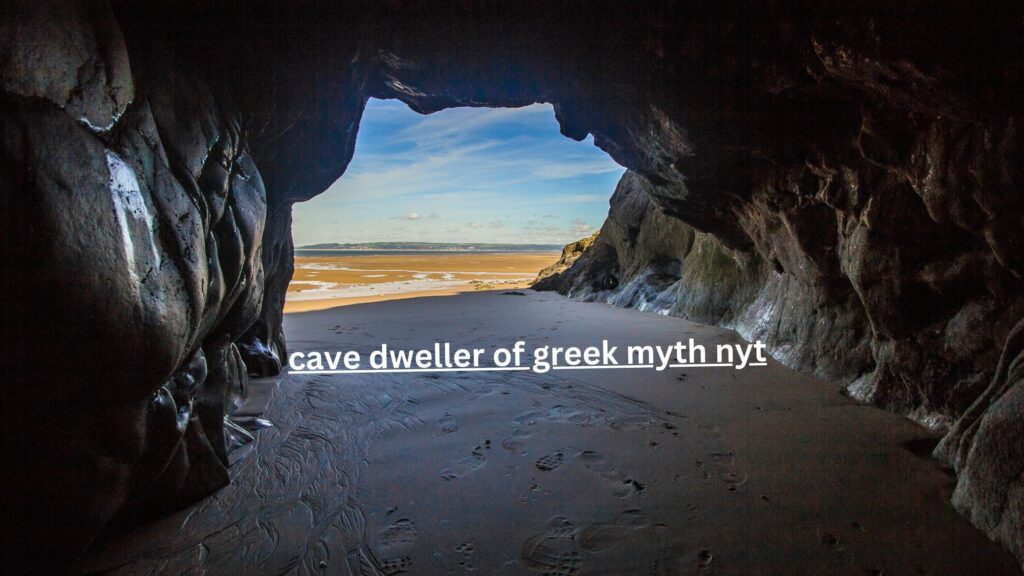In the labyrinthine tapestry of Greek mythology, the enigmatic Cave Dweller of Greek Myth NYT stand as elusive figures, shrouded in mystery and steeped in ancient lore. From the depths of dark caverns to the heights of sacred mountains, these beings embody both terror and wonder, their stories woven into the very fabric of Greek culture. As echoes of their existence reverberate through time, each tale unveils layers of wisdom and fascination, offering glimpses into the human psyche’s timeless quest for meaning and understanding. Join us on a journey into the shadows of mythology, where the secrets of these cave dwellers illuminate the path to discovery and intrigue.
Cave Dweller of Greek Myth NYT: An Overview
Caves in Greek mythology are more than mere geographical features; they are gateways to the unknown, homes to formidable creatures, and places of divine encounters. The Cave Dweller of Greek Myth NYT in these myths are varied and often represent the challenges and mysteries faced by heroes on their quests. From the Cyclopes to the Sibyls, these inhabitants of the dark recesses of the earth are central to many legendary tales.
Cyclopes: The One-Eyed Giants
The Cyclopes, one of the most famous groups of cave dwellers, are gigantic beings with a single eye in the middle of their foreheads. According to Greek mythology, they were skilled blacksmiths who crafted Zeus’s thunderbolts. These formidable creatures were known for their immense strength and terrifying appearance, living in caves far from human civilization. The most well-known Cyclops, Polyphemus, appears in Homer’s “Odyssey,” where he encounters the clever Odysseus.
Polyphemus and Odysseus: A Tale of Wits
Polyphemus, the Cyclops, is perhaps the most famous cave dweller in Greek mythology due to his encounter with Odysseus. Trapped in the Cyclops’s cave, Odysseus and his men had to devise a cunning plan to escape. By intoxicating Polyphemus and blinding his single eye, they managed to slip out of the cave, demonstrating the triumph of wit over brute strength. This tale underscores the dangers and the allure of cave dwellers in Greek myth.
Sibyls: The Prophetic Cave Dwellers
In stark contrast to the brutish Cyclopes, the Sibyls were revered as prophetesses who dwelled in caves. These women were believed to possess divine knowledge and the ability to foretell the future. The most famous of these was the Cumaean Sibyl, who resided in a cave near Cumae in Italy. Her prophecies were highly regarded and often sought by those seeking guidance from the gods.
The Cumaean Sibyl: Guardian of the Underworld
The Cumaean Sibyl played a crucial role in Virgil’s “Aeneid,” where she guided the hero Aeneas through the Underworld. Her cave, an entryway to the realm of the dead, symbolized the transition between life and death. The Sibyl’s ability to bridge these worlds highlights the mystical and often ominous nature of caves in Greek mythology.
The Gorgon Sisters: Medusa and Her Cave
Another iconic cave dweller in Greek myth is Medusa, one of the three Gorgon sisters. Medusa’s story is one of transformation and terror. Once a beautiful maiden, she was cursed by Athena and transformed into a monster with snakes for hair, whose gaze could turn anyone to stone. She lived in a cave, hidden away from the world until the hero Perseus sought her out.
Perseus and the Slaying of Medusa
Perseus’s quest to behead Medusa is a tale of bravery and divine assistance. Armed with gifts from the gods, including a reflective shield from Athena, Perseus entered Medusa’s cave and used the shield to avoid her petrifying gaze. By beheading Medusa, he ended her reign of terror and used her head as a weapon. This story reflects the dual nature of caves as places of danger and opportunity.
Cave of the Nymphs: A Place of Worship and Mystery
In addition to housing monsters and prophets, caves were also sacred spaces dedicated to the worship of nymphs. These divine spirits of nature were believed to inhabit secluded grottos and springs, often receiving offerings from those who sought their favor. The Cave of the Nymphs on Ithaca is one such place, steeped in myth and revered in ancient times.
Odysseus’s Return to Ithaca
The Cave of the Nymphs features in the “Odyssey” as a significant landmark upon Odysseus’s return to his homeland. This cave symbolizes the hero’s journey, his trials, and eventual return to normalcy. The nymphs’ sanctuary highlights the sacred and protective aspects of caves in Greek mythology.
Also Read: YEX Games The Best In Gaming Industry
Caves as Portals to the Underworld
Many caves in Greek myth are portrayed as entrances to the Underworld, the realm of Hades. These gateways to the afterlife underscore the mysterious and often foreboding nature of caves. The river Styx, for example, was said to flow through a cave, marking the boundary between the world of the living and the dead.
The Role of Orpheus in the Underworld
The musician Orpheus ventured into the Underworld through a cave to retrieve his beloved Eurydice. His journey, marked by the enchanting power of his music, exemplifies the themes of love, loss, and the quest for the impossible. Orpheus’s descent and eventual failure to bring Eurydice back highlight the perilous and transformative nature of caves in myth.
Caves as Sites of Divine Birth and Nurture
Some myths also depict caves as places of divine birth and nurture. Zeus, the king of the gods, was hidden in a cave on the island of Crete to protect him from his father Cronus, who sought to devour him. This cave, known as the Diktaean Cave, is celebrated as the birthplace of Zeus and a symbol of safety and divine protection.
The Diktaean Cave: Zeus’s Sanctuary
The Diktaean Cave’s significance in Greek mythology cannot be overstated. It served as a refuge where the infant Zeus was nursed by the goat Amalthea and protected by the Curetes, a group of warrior-dancers. This myth highlights the cave’s role as a sanctuary and a place of transformation from vulnerability to power.
The Cave of Pan: Home of the Rustic God
Pan, the god of the wild, shepherds, and flocks, was also associated with caves. His abode was often depicted as a cave, reflecting his connection to nature and the rustic life. The Cave of Pan, located in various parts of Greece, served as a site for worship and mystical rites.
Pan’s Influence on Greek Culture
Pan’s cave was not just a dwelling but a center of worship and celebration of nature’s fertility. The rituals performed in his honor often involved music, dance, and ecstatic experiences, underscoring the joyous and untamed aspects of the natural world. Pan’s association with caves highlights the harmony between humans and nature in Greek mythology.
Caves and the Oracle of Delphi
The Oracle of Delphi, one of the most significant religious sites in ancient Greece, was closely linked to a cave. The Pythia, the priestess of Apollo, delivered her prophecies from a chasm within the Temple of Apollo. This cave-like chasm was believed to be a source of divine inspiration, connecting the priestess to the god.
The Delphic Oracle: Voice of the Gods
The Delphic Oracle’s pronouncements were sought by individuals and states alike, shaping decisions and guiding actions. The cave’s role as a conduit for Apollo’s voice emphasizes the mystical and revered nature of such sites in Greek culture. The Pythia’s trance-like state, induced by vapors from the chasm, adds to the aura of mystery surrounding the cave.
Caves in Heroic Quests and Trials
Many Greek heroes, including Heracles and Theseus, encountered caves during their adventures. These subterranean spaces often served as the settings for trials that tested their strength, courage, and ingenuity. The Labors of Heracles, for instance, include several cave-related exploits.
Heracles and the Nemean Lion
One of Heracles’s most famous labors was the slaying of the Nemean Lion, a fearsome beast that resided in a cave. The lion’s impenetrable hide made it a formidable opponent, but Heracles’s strength and resourcefulness enabled him to overcome the creature. This labor underscores the symbolic significance of caves as places of challenge and triumph.
Theseus and the Minotaur: The Labyrinthine Cave
The tale of Theseus and the Minotaur is another example of a heroic encounter within a cave-like setting. The Labyrinth, designed by Daedalus, was a complex maze that housed the Minotaur. Theseus’s journey through the Labyrinth to slay the Minotaur represents a descent into the unknown and a battle against a monstrous foe.
The Symbolism of Cave Dweller of Greek Myth NYTMythology
Caves in Greek mythology are rich with symbolic meaning. They represent the unknown, the mystical, and the transformative. Whether serving as homes to monsters, sanctuaries for the divine, or gateways to the Underworld, caves encapsulate the dual nature of danger and refuge. They are places where heroes prove their mettle, where gods reveal their power, and where the mysteries of life and death converge.
Conclusion
The Cave Dweller of Greek Myth NYT mythology, from the Cyclopes and Sibyls to Medusa and Pan, play crucial roles in the ancient narratives that have captivated audiences for centuries. These myths, deeply embedded in Greek culture, offer insights into the values, fears, and aspirations of the ancient Greeks. By exploring these enigmatic figures and their subterranean abodes, we gain a deeper understanding of the rich tapestry of Greek mythology and its enduring influence on Western culture.
Also Read: Unblocked Games 66 EZ: Your Gateway to Free Online Gaming
FAQs
What role do caves play in Greek mythology?
Caves in Greek mythology often serve as homes to mythical creatures, sanctuaries for divine beings, and gateways to the Underworld. They symbolize the unknown, the mystical, and the transformative.
Who are some famous cave dwellers in Greek mythology?
Notable cave dwellers include the Cyclopes (such as Polyphemus), the Cumaean Sibyl, Medusa, and Pan. Each of these figures has a unique story that highlights the diverse roles of caves in Greek myth.
How did Odysseus escape from the Cyclops’s cave?
Odysseus and his men escaped by intoxicating Polyphemus, the Cyclops, and then blinding him. They hid under the sheep as they left the cave, avoiding detection by the blinded Cyclops.
What is the significance of the Delphic Oracle’s cave?
The cave-like chasm in the Temple of Apollo at Delphi was believed to be a source of divine inspiration. The Pythia, the priestess, delivered her prophecies from this chasm, making it a revered site in ancient Greece.
Why are caves often depicted as entrances to the Underworld?
Caves symbolize the unknown and the boundary between life and death. As entrances to the Underworld, they represent the transition from the mortal world to the realm of the dead, emphasizing their mystical and foreboding nature.
What is the story of Theseus and the Minotaur?
Theseus entered the Labyrinth, a complex maze housing the Minotaur, to slay the beast. Guided by Ariadne’s thread, he navigated the maze, killed the Minotaur, and escaped, symbolizing the triumph of courage and ingenuity over monstrous adversity.



